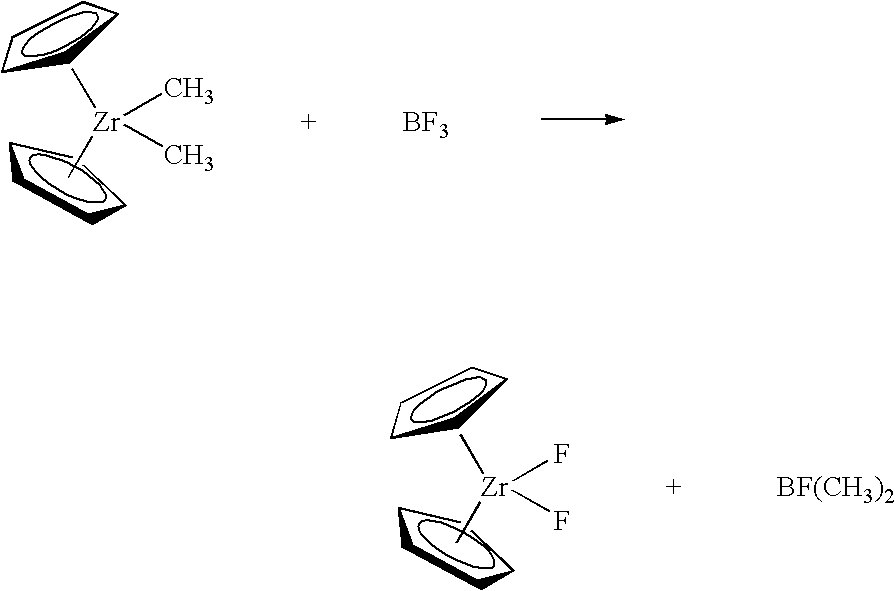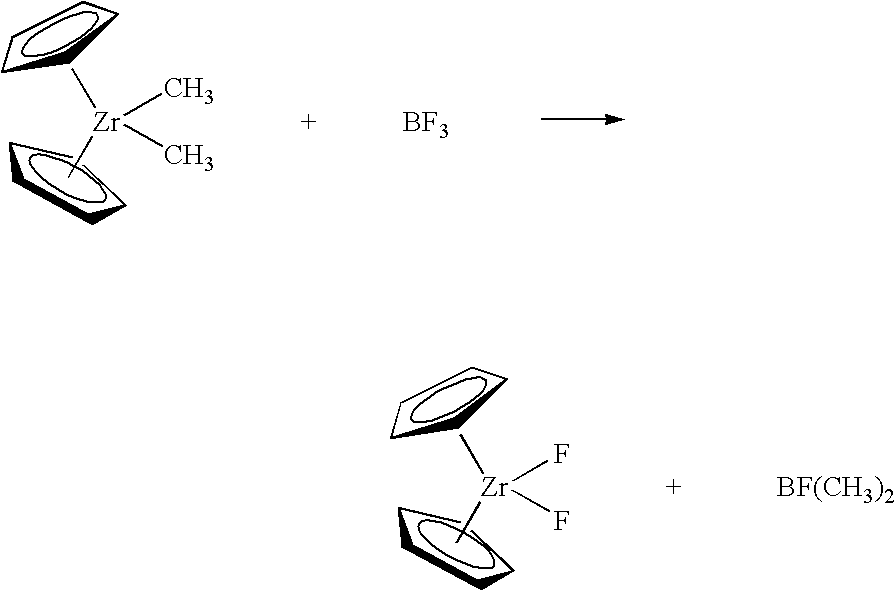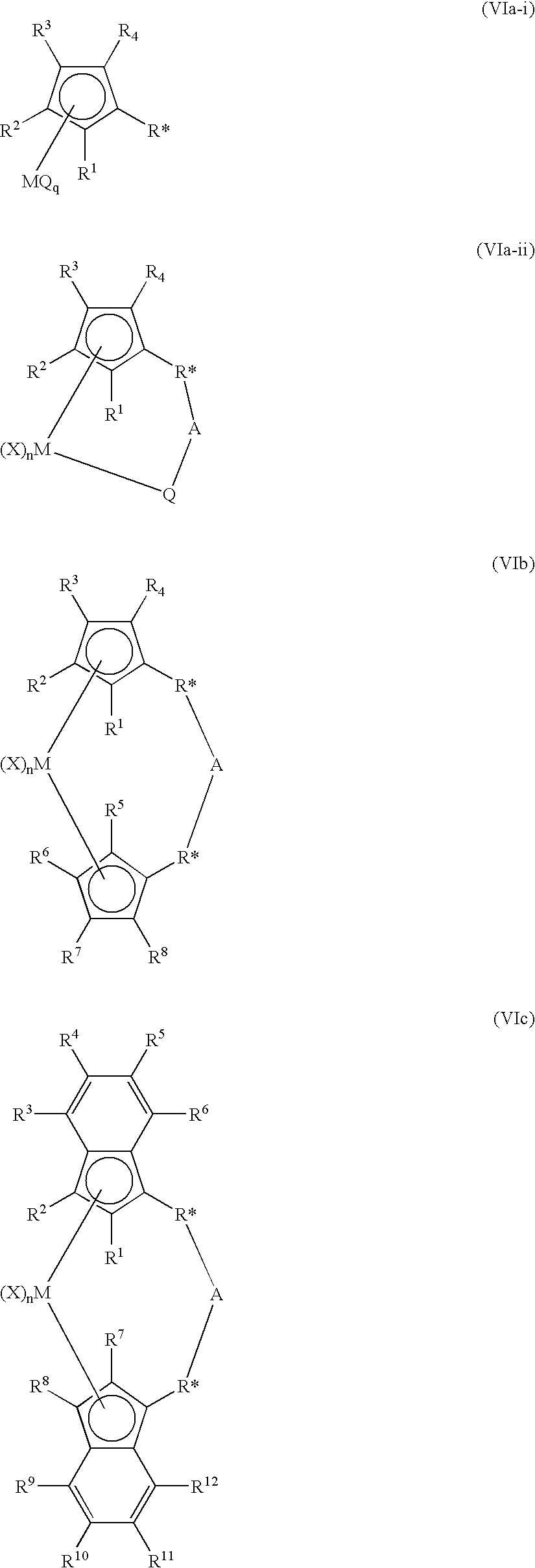Synthesis of polymerization catalyst components
a polymerization catalyst and polymerization technology, applied in the field of polymerization catalyst components synthesis, can solve the problems of uncontrollable phase of olefin polymerization reaction catalyzed using single-site catalyst components, lack of heat removal in the reactor, and often hinder commercial scale up, so as to influence the cost of bulk production and increase or decrease the reaction temperature
- Summary
- Abstract
- Description
- Claims
- Application Information
AI Technical Summary
Benefits of technology
Problems solved by technology
Method used
Image
Examples
example 1
Synthesis of [Me2Si(H4Ind)2]ZrF2
Method A. A 3.0 M solution of MeMgBr (“Me” is methyl) in Et2O (2.9 mL, 8.7 mmol) was added dropwise by syringe to a suspension of [Me2Si(H4Ind)2]ZrCl2 (2.00 g, 4.38 mmol) in Et2O (40 mL) and stirred at room temp. for 18 h. The volatiles were removed under reduced pressure and the residue was extracted with pentane (80 mL). The extract was filtered through a fritted glass filter and neat BF3.OEt2 (0.62 g, 4.4 mmol) was added dropwise by pipette to the stirring solution. After stirring at room temp. for 18 h, the precipitated solid was collected on a flitted glass filter and washed with cold pentane (20 mL). The residual solvent was removed under reduced pressure leaving 1.24 g (2.93 mmol, 67%) of a light tan solid. The compound was identified by comparison of its 1H and 19F NMR spectra to those of a reference sample. Method B. The procedure of Method A was repeated except that MeMgBr was replaced by a 1.4 M solution of MeLi in Et2O (6.3 mL, 8.8 mmol)....
example 2
Synthesis of (BuC5H4)2ZrF2
A 3.0 M solution of MeMgBr in Et2O (3.3 mL, 9.9 mmol) was added dropwise by syringe to a suspension of (BuC5H4)2ZrCl2 (2.00 g, 4.94 mmol) (“Bu” is butyl) in Et2O (50 mL) and stirred at room temp. for 18 h. The volatiles were removed under reduced pressure and the residue was extracted with pentane (70 mL). The extract was filtered through a fritted glass filter and neat BF3.OEt2 (0.70 g, 4.9 mmol) was added dropwise by pipette to the stirring solution. After stirring at room temp. for 18 h, the clear solution was decanted away from an oily residue and concentrated under reduced pressure. The precipitate that formed was collected on a fritted glass filter and washed with cold pentane (10 mL). Residual solvent was removed under reduced pressure leaving 0.66 g (1.8 mmol, 36%) of a white solid. The compound was identified by comparison of its 1H and 19F NMR spectra to those of a reference sample of fluorided metallocene.
example 3
Synthesis of (1,3-Bu,MeC5H3)2ZrF2
A 3.0 M solution of MeMgBr in Et2O (3.1 mL, 9.3 mmol) was added dropwise by syringe to a suspension of (1,3-Bu,MeC5H3)2ZrCl2 (2.00 g, 4.62 mmol) in Et2O (50 mL) and stirred at room temp. for 18 h. The volatiles were removed under reduced pressure and the residue was extracted with pentane (60 mL). The extract was filtered through a fritted glass filter and neat BF3.OEt2 (0.66 g, 4.7 mmol) was added dropwise by pipette to the stirring solution. After stirring at room temp. for 18 h, the slightly cloudy solution was filtered through a fritted glass filter and concentrated down to a thick slurry under reduced pressure. The solid was collected on a fritted glass filter and washed with cold pentane (10 mL). Residual solvent was removed under reduced pressure leaving 1.06 g (2.65 mmol, 57%) of a white solid. The compound was identified by comparison of its 1H and 19F NMR spectra to those of a reference sample of fluorided metallocene.
PUM
| Property | Measurement | Unit |
|---|---|---|
| temperature | aaaaa | aaaaa |
| temperature | aaaaa | aaaaa |
| temperature | aaaaa | aaaaa |
Abstract
Description
Claims
Application Information
 Login to View More
Login to View More - R&D
- Intellectual Property
- Life Sciences
- Materials
- Tech Scout
- Unparalleled Data Quality
- Higher Quality Content
- 60% Fewer Hallucinations
Browse by: Latest US Patents, China's latest patents, Technical Efficacy Thesaurus, Application Domain, Technology Topic, Popular Technical Reports.
© 2025 PatSnap. All rights reserved.Legal|Privacy policy|Modern Slavery Act Transparency Statement|Sitemap|About US| Contact US: help@patsnap.com



